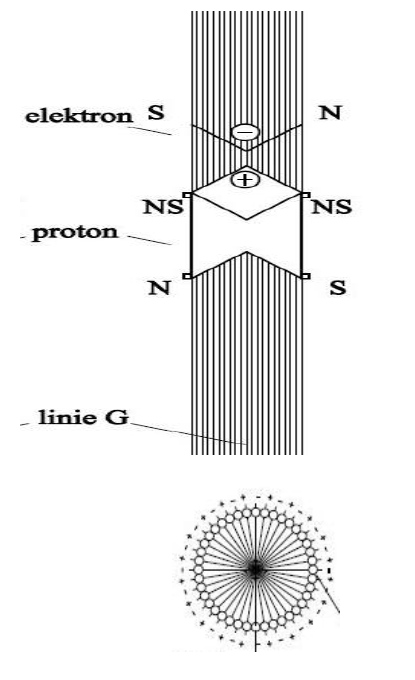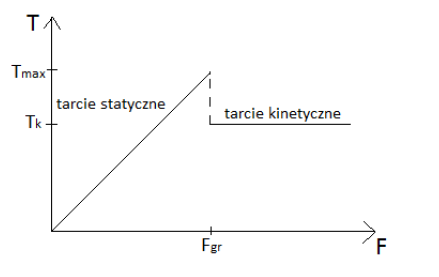Friction occurs when we put two bodies against each other and then start to move them in relation to each other. Two physical phenomena are involved in this process.
The first phenomenon involved in friction is gravity.
As we previously established, an elementary gravitational charge is a neutralized proton. This proton generates an elementary gravitational charge. This charge has a more complex structure than an elementary charge or magnetic charge. It consists of elementary lines G, forming a circle in cross-section and arranged alternately as the lines of attraction (+) and repulsion (-). The alternate arrangement of the lines of attraction and repulsion causes that the bodies only attract each other. The above considerations are illustrated in the figure below. More details regarding the essence of gravity can be found in the main elaboration.

Each atom of a given body is formed from neutralized protons. This means that a given body generates a defined number of elementary gravitational charges equal to the number of neutralized protons forming this body. If two bodies are at a distance from each other, the force of gravity brings them closer. If the bodies come into contact with each other, the force of gravity still presses them against each other with a defined force. This is not the weight of a body (mass) which presses it against the Earth. The gravitational field lines press bodies one to another. The details are presented in the note WE ARE SOLVING THE PROBLEM OF INERTIAL MASS AND GRAVITATIONAL MASS EQUIVALENCE.
For a body situated on the surface of the Earth, its gravitational field lines are “joint” with the Earth’s gravitational field lines. This is a monolith. The bodies cannot move against each other. Now, we want to move the body on the surface of the Earth. The first thing we have to do is to break the gravitational field lines at the contact point of the bodies.

tarcie statyczne – static friction
tarcie kinetyczne – kinetic friction
We have to use a certain force Fgr = Tmax to break the lines. Because always the same number of lines has to be broken, this force is constant regardless of the contact area of the body and the Earth. If, after the lines have been broken, we continue the motion, the field lines of the body and Earth cannot be fully rebuilt. Not fully rebuilt gravitational field lines mean a smaller force Tk necessary to move the body (Tk < Tmax). If we break the motion, the lines will fully rebuild and the body will stay still in relation to the Earth. Resuming the motion after the pause will need carrying out the above procedure again.
Within specified limits, kinetic friction is not dependent on the velocity of the motion of the bodies against each other.
The other phenomenon involved in friction is a perpetual emission of energy quanta (quantum gas, heat) by all bodies.
Two bodies of the same temperature emit energy quanta. If the bodies contact each other, the emitted quanta mostly pass one another and only few of them collide. The temperature of the bodies at their contact point practically does not change. Now, we start to move both the contacting bodies against each other. The situation changes. The frequency of collisions of quanta at the contact point of the bodies increases; the temperature at the contact point of the bodies increases. We increase the velocity of the motion. The frequency of collisions of quanta increases more, the temperature increases more at the contact point of the bodies. With a further increase in the velocity of the motion, the phenomenon described above increases rapidly and so does the temperature. The mutual contact of both the bodies during their motion prevents a quick escape of the quanta to the environment, thus the concentration of the quanta increases, which stimulates an increase in the temperature of the bodies at their contact point even more strongly.
The process of heating-up of the bodies rubbing against each other is very much dependent on the velocity of the motion of the bodies against each other. Mutual attraction and emission of energy quanta occur independently in two bodies in contact. Only when we start to move the bodies against each other, the above mentioned processes give rise to a new physical phenomenon called friction, which results in an increase in the temperature of the bodies at their contact point. The above described process applies to friction between two solids. In the case of a solid and gas, there is practically no static friction.
Both the phenomena described above are related to the subatomic world. Physicist refer all friction-related considerations only to the world of atoms, therefore until now, not even a shadow of a reasonable theory of this process has come into being.
There is still one more problem to explain. What is the role of lubricant in friction?
The explanation is as follows. Lubricant located between bodies prevents their accurate contact, that is their complete mutual stoppage, thus the force Tmax necessary to break the gravitational field lines and the force Tk necessary to move the bodies can be smaller.

